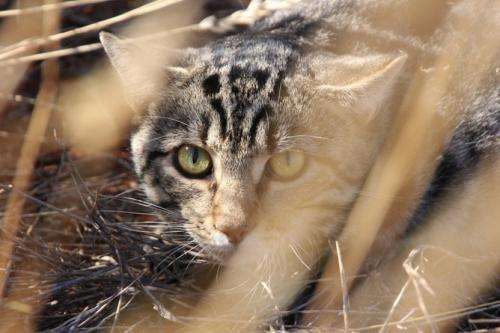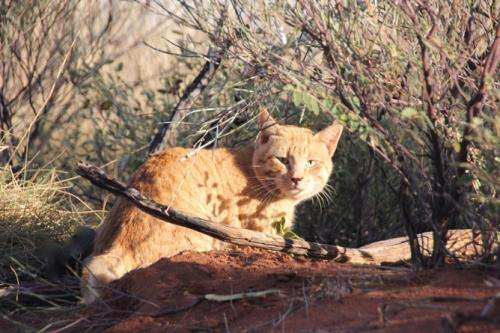A feral cat in the bush. Credit: Tim Doherty, Author provided
Feral domestic cats are a global threat to biodiversity and were recently named as the biggest threat to endangered Australian mammals.
But what about your pet cat, or the local stray? While any kind of domestic cat can kill wildlife, there's no "one size fits all" way to manage their impact.
Before we figure out how best to manage cats, we first need to distinguish between the different categories.
What's in a name?
There are likely more than 10 million feral cats in Australia, and each year tens of thousands of stray cats are put down in Australian cities.
But there are several ways to classify cats. They include: pet cat, house cat, domestic cat, stray, feral, semi-feral, unowned, colony cat and free-roaming, amongst others.
Despite the plethora of systems, we can make a couple of generalisations. Common characteristics that are used in defining different groups of cats include their degree of socialisation, ancestry, ownership, fear of humans and reliance on humans for their care.
The broadest two groups that can be identified are "owned" cats, which live in a household where they are fed and cared for by humans, and "unowned" cats that do not live in a household and may or may not be fed or cared for. The term "free-roaming", on the other hand, can include both owned and unowned cats, since it generally refers to a lack of confinement.
Both owned and unowned cats can kill wildlife, so the term free-roaming is useful for management in cities where both groups co-exist.
Stray or semi-feral cats are those that were once owned and part of a household but have since become lost or dumped by their owners. Stray cats are partly or wholly dependent on humans for the provision of food and shelter and colony cats are stray cats that live in groups fed by members of the public, but are not officially owned or cared for.
A feral cat in the bush. Credit: Tim Doherty
Feral cats on the other hand, have no degree of socialisation or dependence on humans.
Claws for concern
In Australia, feral cats outnumber stray and pet cats in terms of both absolute numbers and their relative impacts on native fauna. Feral cats prey on hundreds of species of birds, mammals and reptiles and have contributed to the extinction of more than 20 mammal species. It's estimated that tens of millions of native animals are eaten by feral cats each night.
Make no mistake though, some stray and pet cats are natural born killers too. The majority of wildlife taken by cats in urban areas are likely to be rats, mice and common bird species, but cats are also a potential threat to endangered species that live in urban areas, like the western ringtail possum in Busselton, Western Australia and the southern brown bandicoot in south-eastern Melbourne.
A matter of life and death
Whether a cat is named as stray or feral could mean the difference between life and death for the animal.
Under New Zealand's Animal Welfare Act, feral cats can be killed. Killing is acceptable for stray cats too, except where there is evidence of ownership, in which case the cat must be sent to a shelter for at least seven days.
The regulations in Australia are more complex, because each State and Territory has its own set of legislation. Nevertheless, feral cats are recognised as a pest and hence are subject to lethal control across Australia.
Under the guidelines of the International Society of Feline Medicine, stray cats qualify for rehoming, whereas feral cats do not. However, both groups of cats qualify for trap-neuter-return (TNR; a vexed issue in itself), and then "occasionally euthanasia" as a last resort.
Not everyone agrees on the best way to manage cats. One study from the US, perhaps unsurprisingly, found that the opinions of cat colony caretakers and bird conservation professionals were highly polarized, and a study from the UK found that cat rescue workers considered that most cats could be tamed and rehomed, whereas veterinarians generally considered that this was inappropriate for feral cats.
In Illinois, rural residents were more likely to support lethal control of feral cats compared to urban residents , and in Western Australia, cat owners were less concerned about wildlife impacts and were less likely to favour controls than non-cat owners.
How to help
Managing the impacts of different groups of cats on wildlife requires different approaches. Keeping your pet cat indoors or confined to your property can prevent it from killing wildlife.Collar-mounted predation deterrents like bells or pounce protectors can reduce predation rates. Also, having your male cat desexed will prevent it from breeding with other free-roaming cats and hence contributing new kittens to the stray population. Desexing your female cat avoids the problem of rehoming kittens.
Trap-neuter-return of stray and colony cats does nothing to prevent individual cats from killing wildlife. Feeding is ineffective too because cats may hunt even if they're not hungry. Removal of stray cats from urban areas is the only way to stop them from eating wildlife.
Landscape scale control of feral cats in Western Australia can be achieved through annual aerial baiting and this is currently being tested in other parts of Australia too. Unfortunately though, the cats always come back, especially in good rainfall years. Predator-proof fencing and predator-free islands are important sanctuaries for threatened fauna that can't survive even low levels of cat predation.
The future is looking pretty grim for Australian wildlife and reducing the impacts of cats in all categories is an essential component of fauna conservation plans, especially for our endangered birds and mammals.
Source: The Conversation
This story is published courtesy of The Conversation (under Creative Commons-Attribution/No derivatives).
![]()























